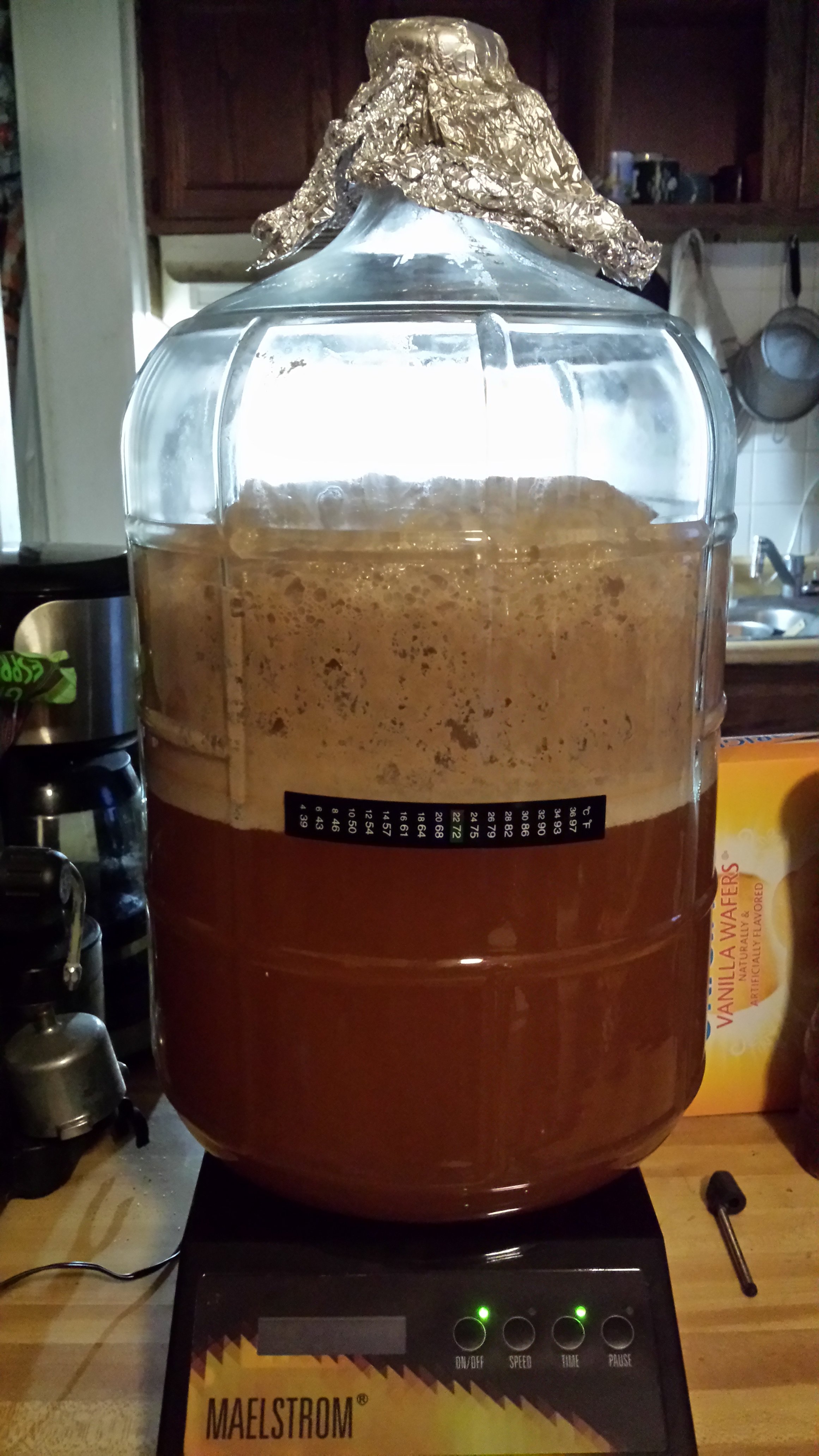Hi all,
Until I get an open fermentation system setup properly (I have a square - thanks to a member here - just not ready to implement it yet), I will continue to brew using sanke's, and transferring via CO2 transfer.
I have a yeast from a Yorkshire square brewery, employing regular rousings via pumping up and over, through a spreading fan.
Because I'll be fermenting in a sanke, I cannot rouse it as efficiently and would like to compare methods anyway. I typically ferment to a few points above FG, xfer, dry hop x 3 days, crash cool (with finings), and xfer to brite serving tank. I'll probably do that here - just getting beer to ourselves and friends, and will be moving to a more traditional approach as I get back in.
I always used WLP023 to great effect for all my bitters. I'll definitely be using the HH, the yeast I obtained from Brewlabs, but for now, I've been out of the game a really long time and suspect I'm out of the loop on a lot of choices. For a traditional, English strong bitter, any thoughts?
FWIW, here's the particulars on a First Gold-based strong bitter:
03-18-2018 Strong Bitter - 15 - first gold
A ProMash Brewing Session Report
--------------------------------
Batch Size (Gal): 13.00 Wort Size (Gal): 13.00
Total Grain (Lbs): 27.62
Anticipated OG: 1.058 Plato: 14.33
Anticipated SRM: 15.2
Anticipated IBU: 42.5
Brewhouse Efficiency: 75 %
Wort Boil Time: 90 Minutes
Grain/Extract/Sugar
% Amount Name Origin Potential SRM
-----------------------------------------------------------------------------
85.1 23.50 lbs. Fawcett - Maris Otter England 1.037 3
1.8 0.50 lbs. Hugh Baird Crystal 135-160 Great Britain 1.033 150
6.3 1.75 lbs. Crystal 77 US 1.034 77
0.2 0.06 lbs. Chocolate Malt Great Britain 1.034 475
0.5 0.13 lbs. De-Bittered Black Belgium 1.010 550
6.1 1.69 lbs. Torrefied Wheat Great Britain 1.036 3
Potential represented as SG per pound per gallon.
Hops
Amount Name Form Alpha IBU Boil Time
-----------------------------------------------------------------------------
2.25 oz. Challenger Pellet 7.50 33.8 90 min.
2.00 oz. First Gold Pellet 7.50 5.5 10 min.
1.50 oz. First Gold Pellet 7.50 0.0 0 min.
1.50 oz. First Gold Pellet 7.50 0.0 Dry Hop
Yeast
-----
White Labs WLP023 Burton Ale
Mash Schedule
-------------
Mash Name: ESB - moderate dextrin balanced w/ moderate crystal in grist
Total Grain Lbs: 27.62
Total Water Qts: 27.98 - Before Additional Infusions
Total Water Gal: 6.99 - Before Additional Infusions
Tun Thermal Mass: 0.00
Grain Temp: 67 F
Step Rest Start Stop Heat Infuse Infuse Infuse
Step Name Time Time Temp Temp Type Temp Amount Ratio
---------------------------------------------------------------------------------
Mash in Temp 5 60 154 154 Infuse 171 27.98 1.01
Mashout 5 15 170 170 Infuse 210 13.40 1.50
Total Water Qts: 41.38 - After Additional Infusions
Total Water Gal: 10.35 - After Additional Infusions
Total Mash Volume Gal: 12.56 - After Additional Infusions
All temperature measurements are degrees Fahrenheit.
All infusion amounts are in Quarts.
All infusion ratios are Quarts/Lbs.
Until I get an open fermentation system setup properly (I have a square - thanks to a member here - just not ready to implement it yet), I will continue to brew using sanke's, and transferring via CO2 transfer.
I have a yeast from a Yorkshire square brewery, employing regular rousings via pumping up and over, through a spreading fan.
Because I'll be fermenting in a sanke, I cannot rouse it as efficiently and would like to compare methods anyway. I typically ferment to a few points above FG, xfer, dry hop x 3 days, crash cool (with finings), and xfer to brite serving tank. I'll probably do that here - just getting beer to ourselves and friends, and will be moving to a more traditional approach as I get back in.
I always used WLP023 to great effect for all my bitters. I'll definitely be using the HH, the yeast I obtained from Brewlabs, but for now, I've been out of the game a really long time and suspect I'm out of the loop on a lot of choices. For a traditional, English strong bitter, any thoughts?
FWIW, here's the particulars on a First Gold-based strong bitter:
03-18-2018 Strong Bitter - 15 - first gold
A ProMash Brewing Session Report
--------------------------------
Batch Size (Gal): 13.00 Wort Size (Gal): 13.00
Total Grain (Lbs): 27.62
Anticipated OG: 1.058 Plato: 14.33
Anticipated SRM: 15.2
Anticipated IBU: 42.5
Brewhouse Efficiency: 75 %
Wort Boil Time: 90 Minutes
Grain/Extract/Sugar
% Amount Name Origin Potential SRM
-----------------------------------------------------------------------------
85.1 23.50 lbs. Fawcett - Maris Otter England 1.037 3
1.8 0.50 lbs. Hugh Baird Crystal 135-160 Great Britain 1.033 150
6.3 1.75 lbs. Crystal 77 US 1.034 77
0.2 0.06 lbs. Chocolate Malt Great Britain 1.034 475
0.5 0.13 lbs. De-Bittered Black Belgium 1.010 550
6.1 1.69 lbs. Torrefied Wheat Great Britain 1.036 3
Potential represented as SG per pound per gallon.
Hops
Amount Name Form Alpha IBU Boil Time
-----------------------------------------------------------------------------
2.25 oz. Challenger Pellet 7.50 33.8 90 min.
2.00 oz. First Gold Pellet 7.50 5.5 10 min.
1.50 oz. First Gold Pellet 7.50 0.0 0 min.
1.50 oz. First Gold Pellet 7.50 0.0 Dry Hop
Yeast
-----
White Labs WLP023 Burton Ale
Mash Schedule
-------------
Mash Name: ESB - moderate dextrin balanced w/ moderate crystal in grist
Total Grain Lbs: 27.62
Total Water Qts: 27.98 - Before Additional Infusions
Total Water Gal: 6.99 - Before Additional Infusions
Tun Thermal Mass: 0.00
Grain Temp: 67 F
Step Rest Start Stop Heat Infuse Infuse Infuse
Step Name Time Time Temp Temp Type Temp Amount Ratio
---------------------------------------------------------------------------------
Mash in Temp 5 60 154 154 Infuse 171 27.98 1.01
Mashout 5 15 170 170 Infuse 210 13.40 1.50
Total Water Qts: 41.38 - After Additional Infusions
Total Water Gal: 10.35 - After Additional Infusions
Total Mash Volume Gal: 12.56 - After Additional Infusions
All temperature measurements are degrees Fahrenheit.
All infusion amounts are in Quarts.
All infusion ratios are Quarts/Lbs.






